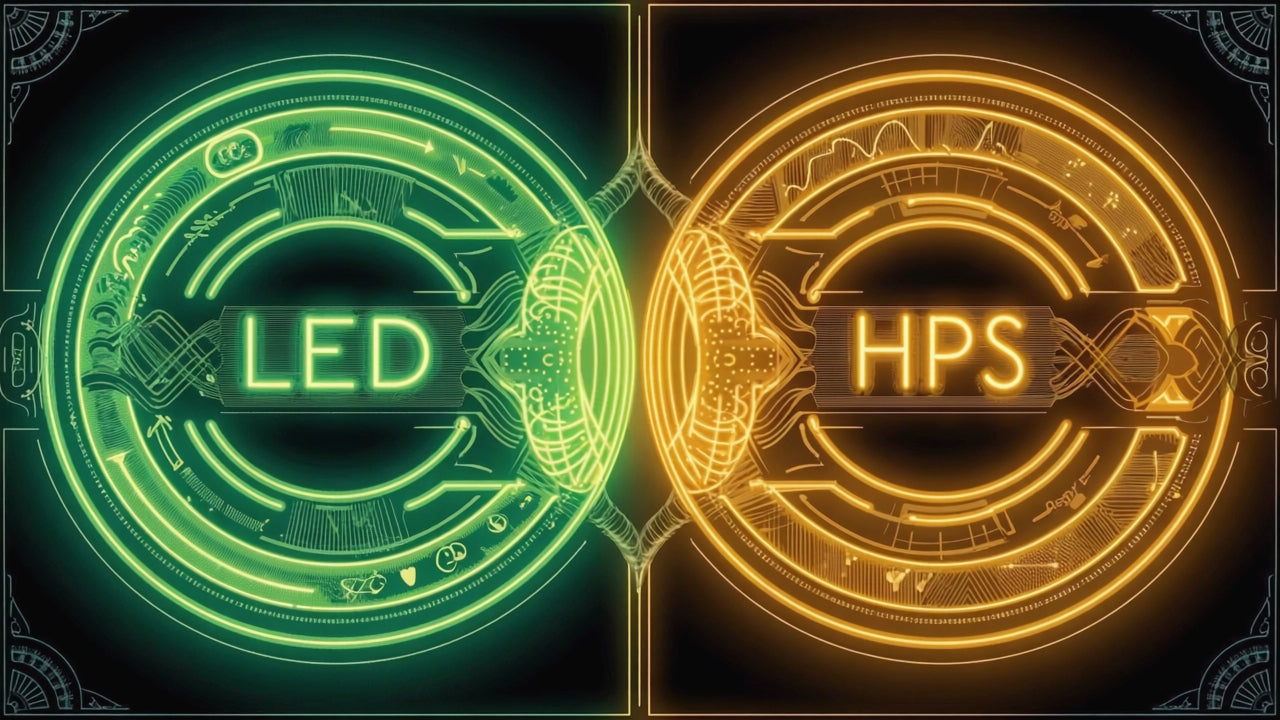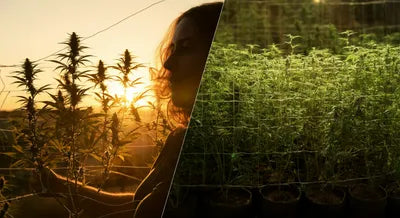
LED vs HPS Grow Lights: Which is Better for Indoor Growing in 2025?
Choosing the right grow light technology is one of the most critical decisions for indoor gardening success. The battle between LED and HPS (High Pressure Sodium) grow lights has evolved dramatically, with each technology offering distinct advantages for different growing scenarios. Whether you're a beginner setting up your first grow tent or an experienced cultivator considering an upgrade, understanding the real-world differences between LED and HPS lights ensures you make the best choice for your specific needs and budget.
Quick Answer: LED grow lights are superior for most indoor growing applications in 2025, offering 50-80% energy savings, longer lifespan (50,000+ hours), lower heat output, and customizable full-spectrum lighting. HPS lights remain competitive for large commercial operations where initial cost matters more than long-term efficiency. LED technology has advanced significantly, providing equal or better yields while dramatically reducing operating costs and heat management challenges.
Understanding LED vs HPS Technology Fundamentals
LED Grow Light Technology
LED (Light Emitting Diode) grow lights represent the latest evolution in horticultural lighting. These lights use semiconductor technology to convert electricity directly into light with minimal heat waste. Modern LED grow lights feature multiple diodes that can be precisely tuned to emit specific wavelengths optimal for plant photosynthesis.
Key LED characteristics:
- Direct light conversion: Electricity converts to light with minimal energy loss
- Spectral precision: Targeted wavelengths for specific plant needs
- Modular design: Multiple diodes for uniform light distribution
- Digital control: Smart features and automation capabilities
HPS Grow Light Technology
HPS (High Pressure Sodium) lights use an electrical arc through pressurized sodium vapor to produce light. These lights have been the commercial growing standard for decades, providing intense illumination with proven results.
Key HPS characteristics:
- Arc tube technology: High-intensity light from pressurized sodium
- Broad spectrum output: Wide wavelength coverage with yellow/red emphasis
- Proven performance: Decades of commercial growing success
- Single-point source: Intense light from central bulb

Comprehensive Performance Comparison
Energy Efficiency and Operating Costs
LED Advantages:
- 50-80% energy savings: Modern LEDs consume significantly less power for equivalent light output
- Targeted spectrum efficiency: No wasted energy on unusable wavelengths
- Lower HVAC costs: Reduced heat generation means less cooling required
- Longer operational life: 50,000+ hour lifespan vs 10,000-20,000 for HPS
HPS Performance:
- Higher power consumption: 400-1000 watts typical for comparable coverage
- Heat generation: 60-70% of energy converts to heat rather than usable light
- Frequent replacement: Bulbs need replacement every 1-2 growing seasons
- Additional cooling costs: Requires robust ventilation and cooling systems
Real-world example: A Gorilla Xi750 LED consumes 750 watts to cover a 4x4 area, while an equivalent HPS setup requires 1000+ watts plus additional cooling, resulting in 40-50% higher total energy consumption.
Light Spectrum and Plant Response
LED Spectrum Advantages:
- Full spectrum capability: Targeted full spectrum designed specifically for plant needs
- Customizable wavelengths: Adjust spectrum for different growth stages
- Blue light precision: 400-500nm optimized for vegetative growth
- Red light efficiency: 600-700nm maximized for flowering
- UV/IR control: Advanced models include beneficial UV and infrared
HPS Spectrum Characteristics:
- Yellow/red heavy: Strong in 570-700nm range, excellent for flowering
- Limited blue: Requires supplementation for optimal vegetative growth
- Fixed spectrum: Cannot adjust wavelengths for different growth stages
- Broad wavelength coverage: Includes some wavelengths plants don't utilize efficiently
Growth stage optimization:
- LEDs: Can be tuned for seedling, vegetative, and flowering stages
- HPS: Typically requires different bulb types (MH for veg, HPS for flower)
Heat Management and Environmental Control
LED Heat Advantages:
- Minimal heat generation: 80-90% energy converts to light, not heat
- Placement flexibility: Can position closer to plants (12-18 inches)
- Reduced cooling needs: Minimal impact on grow tent temperature
- Uniform heat distribution: Multiple diodes spread heat evenly
HPS Heat Challenges:
- Significant heat output: 60-70% of energy becomes heat
- Distance requirements: Must maintain 24-36 inches from plants
- Cooling necessity: Requires powerful ventilation and often air conditioning
- Hot spots: Single-point heat source creates temperature gradients
Climate control impact:
- LED setups: Maintain stable temperatures with basic ventilation
- HPS setups: Often require dedicated cooling systems and heat management
Yield Potential and Growing Results
LED Growing Performance
Modern LED technology has reached parity or superiority in yield potential compared to HPS lights. Advanced LED grow lights provide precise PPFD (Photosynthetic Photon Flux Density) levels optimized for maximum plant response.
LED yield factors:
- Optimal PPFD delivery: 800-1200 μmol/m²/s for flowering without excessive heat
- Even light distribution: Multiple light sources eliminate shadows and hot spots
- Spectrum optimization: Targeted wavelengths maximize photosynthetic efficiency
- Consistent performance: Stable output throughout LED lifespan
HPS Growing Performance
HPS lights have a proven track record in commercial growing operations, particularly for large-scale cultivation where initial investment costs are prioritized over long-term efficiency.
HPS yield factors:
- High light intensity: Excellent canopy penetration for large plants
- Proven genetics response: Many plant varieties bred under HPS lighting
- Commercial track record: Decades of successful large-scale cultivation
- Single-source intensity: High PPFD levels from central light source
Yield comparison studies: Recent comparative studies show LED lights achieving 10-30% higher yields per watt consumed, primarily due to improved spectrum efficiency and better environmental control.
Cost Analysis: Initial Investment vs Long-term ROI
Initial Setup Costs
LED Investment:
- Higher upfront cost: $200-800 for quality LED fixtures
- Complete package value: Often includes drivers, controls, and warranties
- Infrastructure savings: Reduced ventilation and cooling requirements
- Immediate efficiency: No warm-up time or performance degradation
HPS Investment:
- Lower initial cost: $100-300 for HPS fixtures and ballasts
- Additional equipment needed: Reflectors, ballasts, and cooling systems
- Infrastructure costs: Enhanced ventilation and cooling requirements
- Replacement planning: Budget for regular bulb replacements
Long-term Operating Costs
LED Long-term Value:
- Energy savings: 50-80% reduction in electricity costs
- Minimal maintenance: No bulb replacements for 7-10 years
- Reduced cooling costs: Lower HVAC expenses
- Stable performance: Consistent light output over lifespan
HPS Long-term Costs:
- Higher energy bills: Significantly more electricity consumption
- Regular replacements: Bulb replacement every 10,000-20,000 hours
- Cooling expenses: Substantial ventilation and air conditioning costs
- Performance degradation: Decreasing light output over bulb life
ROI Timeline: Quality LED lights typically pay for themselves within 12-24 months through energy savings and reduced replacement costs.
Practical Setup and Installation Considerations
LED Installation Requirements
Setup simplicity:
- Plug-and-play operation: Most LEDs require minimal setup
- Lightweight design: Easy mounting with standard rope ratchets
- Flexible positioning: Can adjust height easily as plants grow
- Multiple mounting options: Panels, bars, or individual fixtures
Infrastructure needs:
- Standard electrical: Most operate on 120V household current
- Basic ventilation: Minimal cooling requirements
- Simple controls: Many include built-in timers and spectrum control
- Expandable systems: Easy to add additional fixtures
HPS Installation Requirements
Setup complexity:
- Professional installation: Often requires electrical expertise
- Heavy fixtures: Requires robust mounting systems
- Ballast setup: Separate ballast installation and wiring
- Reflector optimization: Proper positioning for light distribution
Infrastructure demands:
- Higher voltage: Often requires 240V circuits for larger systems
- Enhanced ventilation: Powerful inline fans and ducting
- Cooling systems: May require air conditioning in sealed environments
- Fire safety: Higher heat output requires additional safety considerations
Technology Evolution and Future Trends
LED Innovation Trajectory
LED technology continues advancing rapidly, with new improvements appearing regularly:
Current innovations:
- Quantum board technology: Improved efficiency and light distribution
- Smart automation: App-controlled systems with environmental integration
- Spectrum customization: Precise wavelength control for specific plant responses
- UV and far-red integration: Enhanced secondary metabolite production
Future developments:
- Increased efficiency: Targeting 4.0+ μmol/J efficacy
- AI integration: Machine learning optimization for plant responses
- Wireless power: Eliminating wiring for modular systems
- Integrated sensors: Built-in environmental monitoring and response
HPS Technology Maturity
HPS technology has reached maturity with limited innovation potential:
Current state:
- Mature technology: Minor efficiency improvements possible
- Double-ended improvements: Better efficiency and bulb life
- Ceramic metal halide: Some spectrum improvements
- Digital ballasts: Improved control and efficiency
Market position:
- Commercial holdout: Still used in large operations for cost reasons
- Declining adoption: New growers predominantly choose LED
- Legacy systems: Existing installations maintain HPS temporarily
- Niche applications: Specific uses where heat is beneficial
Specific Use Case Recommendations
When to Choose LED Grow Lights
Ideal LED scenarios:
- Home growing: Personal cultivation in tents or small spaces
- Energy consciousness: Priority on reducing electricity costs
- Heat-sensitive environments: Basement or enclosed growing areas
- Automation interest: Desire for smart controls and monitoring
- Multiple growth stages: Need for spectrum customization
- Long-term growing: Planning multi-year growing operations
Best LED applications:
- 2x2 to 5x5 grow tents: Perfect for tent growing
- Apartment/residential growing: Minimal heat and noise
- Perpetual harvest systems: Different spectrums for different stages
- High-value crops: Maximum quality and potency focus
When to Consider HPS Lights
Suitable HPS scenarios:
- Large commercial operations: Cost per square foot considerations
- Cold environments: Heat generation can be beneficial
- Proven strain genetics: Varieties specifically bred under HPS
- Budget constraints: Lower initial investment requirements
- High-ceiling spaces: Adequate clearance for heat management
Best HPS applications:
- Commercial warehouses: Large-scale production focus
- Greenhouse supplementation: Integration with natural light
- Cold climate growing: Heat generation provides environmental benefit
- Bulk commodity production: Cost prioritized over efficiency
Environmental Impact and Sustainability
LED Environmental Benefits
Energy efficiency impact:
- Reduced carbon footprint: 50-80% less electricity consumption
- Grid demand reduction: Lower peak power requirements
- Renewable energy compatibility: Efficient use of solar/wind power
- Heat reduction: Less HVAC load reduces overall energy consumption
Material and waste considerations:
- Longer lifespan: Less frequent replacement reduces waste
- Recyclable components: LED components can be recycled
- No toxic materials: No mercury or other hazardous substances
- Reduced packaging waste: Fewer replacement bulbs needed
HPS Environmental Considerations
Energy and emissions:
- Higher carbon footprint: Increased electricity consumption
- Grid strain: Higher peak power demands
- Cooling requirements: Additional HVAC energy consumption
- Heat waste: Significant energy lost as unusable heat
Waste and materials:
- Frequent replacements: Regular bulb disposal requirements
- Hazardous materials: May contain mercury or other toxins
- Ballast waste: Electronic ballasts require special disposal
- Packaging waste: Multiple replacement bulbs over LED lifespan

Common Myths and Misconceptions
LED Myth Debunking
Myth: "LEDs don't produce enough heat for plants" Reality: Plants need light energy, not heat. LED efficiency means more energy goes to light production rather than waste heat. Proper environmental control maintains optimal growing temperatures.
Myth: "HPS penetrates canopy better" Reality: Proper LED placement and multiple light sources provide superior canopy penetration with even distribution and no hot spots.
Myth: "LEDs are too expensive" Reality: While initial costs are higher, LEDs pay for themselves quickly through energy savings and eliminate ongoing bulb replacement costs.
HPS Myth Clarification
Myth: "HPS always produces bigger yields" Reality: Modern LEDs match or exceed HPS yields while using significantly less energy. Yield quality often improves with optimized LED spectrums.
Myth: "HPS is more reliable" Reality: HPS bulbs degrade rapidly and require frequent replacement. LED fixtures operate consistently for years without maintenance.
Myth: "HPS heat is always beneficial" Reality: Excessive heat often requires expensive cooling systems and can stress plants. Controlled environments with LEDs provide better growing conditions.
Making the Right Choice for Your Setup
Decision Framework
Consider these key factors when choosing between LED and HPS:
Budget considerations:
- Short-term budget: HPS lower initial cost
- Long-term budget: LED significantly more economical
- Total cost of ownership: Include energy and replacement costs
Growing environment:
- Space size: LEDs better for small to medium spaces
- Ventilation capability: HPS requires substantial airflow
- Ambient temperature: LEDs better for warm environments
Growing goals:
- Efficiency priority: LED clear winner
- Maximum yield: Both can achieve excellent results
- Automation interest: LED offers advanced features
- Simplicity preference: Both can be simple with proper setup
Upgrade Strategy
Transitioning from HPS to LED:
- Gradual replacement: Replace HPS fixtures as they fail
- Hybrid approach: Use both technologies during transition
- Complete upgrade: Replace entire system for maximum benefit
- Sell existing equipment: Recover some HPS investment
Starting fresh:
- LED recommended: Unless specific constraints favor HPS
- Future-proof choice: LED technology continues improving
- Infrastructure planning: Design for LED requirements
- Scalability consideration: Plan for expansion with consistent technology
Frequently Asked Questions
Do LED grow lights really work as well as HPS for indoor growing?
Yes, modern LED grow lights match or exceed HPS performance while using 50-80% less energy. Full-spectrum LEDs provide targeted wavelengths for optimal plant growth, often producing higher yields per watt consumed than HPS lights.
What's the main advantage of HPS over LED grow lights?
HPS lights have lower initial purchase costs and provide intense light output that some growers prefer for large commercial operations. However, the total cost of ownership typically favors LED lights due to energy savings and longer lifespan.
How much money can I save switching from HPS to LED?
Energy savings range from 50-80% depending on the specific lights compared. A typical 4x4 setup switching from 1000W HPS to 600W LED saves approximately $200-400 annually in electricity costs, plus eliminates bulb replacement expenses.
Can I use both LED and HPS lights together?
Yes, hybrid lighting systems can work well, combining HPS intensity with LED efficiency and spectrum control. Many growers use this approach during transitions or for specific growing techniques that benefit from multiple light sources.
Which technology is better for beginners?
LED lights are generally better for beginners due to lower heat output, energy efficiency, and simpler environmental control. They're more forgiving and require less complex ventilation systems than HPS setups.
Summary
LED grow lights represent the superior choice for most indoor growing applications in 2025, offering significant advantages in energy efficiency, heat management, spectrum control, and long-term costs. While HPS lights maintain lower initial costs, LEDs provide better total value through reduced operating expenses and improved growing conditions. Choose LED for home growing, energy efficiency, and future-proof technology. Consider HPS only for specific commercial applications where initial cost outweighs long-term efficiency. The technology gap continues widening in LED's favor as innovations advance.
Ready to Upgrade Your Growing with Advanced LED Technology?
Experience the future of indoor growing with Gorilla's advanced LED grow light collection. From the efficient Xi220 for small spaces to the powerful Xi750 for maximum production, every LED fixture features targeted full-spectrum technology and smart automation capabilities. Combine with Gorilla's industry-leading grow tents for the ultimate indoor growing system that maximizes yields while minimizing energy costs. Start growing smarter, not harder, with equipment designed by Northern California's elite growers for serious cultivation success.
Related Articles:

Lena Myles
I'm a mushroom enthusiast and home cook based in Oregon. I'm passionate about foraging and creating fungi-focused recipes, especially delicious, plant-based dishes using gourmet mushrooms like trumpet, shiitake, and oyster. When I’m not in the kitchen, you’ll usually find me wandering the woods in search of new wild flavors.


